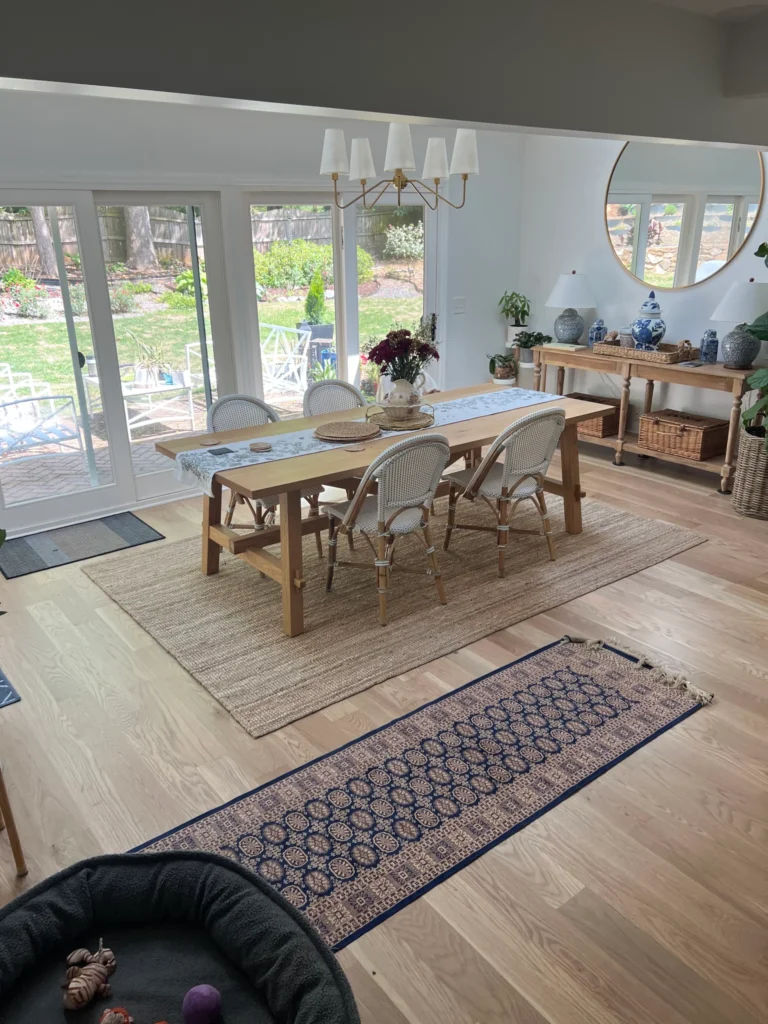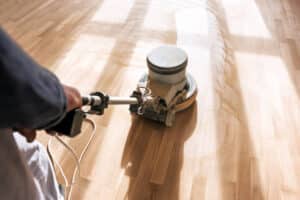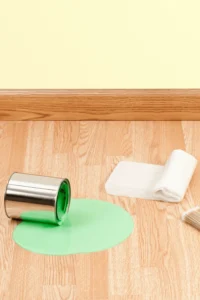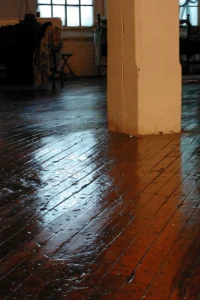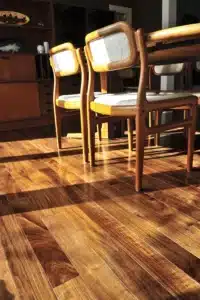Keeping hardwood floors clean and shiny can be a challenging task, especially without the right tools. 🔧
One of the most essential tools for maintaining hardwood floors is a dust mop! But with a plethora of options available on the market, choosing the best dust mop for hardwood floors can feel a little tough! Daunting.
Let’s explore the importance of using the right dust mops so you can make your floors look and feel clean and pristine every day!
Why Use a Dust Mop for Hardwood Floors?
But first– why dust mops for hardwood floors?
The thing is, traditional brooms, while effective at sweeping up larger debris, can actually be damaging to hardwood floors.
Their stiff bristles can scratch and dull the surface over time, leading to costly repairs or refinishing.
Alternatively, a dust mop is designed to trap dust, dirt, and pet hair without causing any damage. Its soft, microfiber material glides smoothly over the floor, picking up particles instead of pushing them around. This not only keeps your floors looking pristine but also helps maintain their longevity.
Types of Dust Mops
When it comes to dust mop for hardwood floors, there are several options to choose from, each with its own set of features and benefits.
Flat mops have a flat head and are often made of microfiber or other absorbent materials. They’re great for quickly picking up dust and debris on hard floors.
Looped-end mops: These mops have looped ends that prevent fraying and provide better durability. They’re often used for larger cleaning areas and can be more effective at trapping dust.
Disposable dust mops: These are typically made of a disposable material like paper or microfiber. They’re great for one-time use and can be thrown away after cleaning.
Spray mops: These mops have a built-in spray mechanism that allows you to spray cleaning solution directly onto the floor as you mop. They’re both convenient for cleaning and require less water.
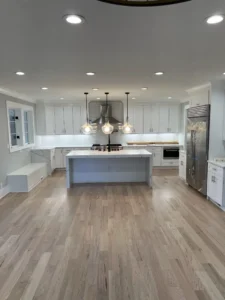
Treated dust mops: These mops have been treated with a dust-attracting chemical or oil to improve their dust-trapping capabilities and are often used in commercial settings.
Electric dust mops: These are powered by electricity and use a rotating brush or pad to sweep up dust and debris. They are effective for large cleaning areas but require electricity to operate.
Our Recommendation
But the one we recommend? Microfiber dust mops, are among the most popular choices due to their ability to effectively trap dust and dirt particles.
They’re gentle on hardwood floors and can be used dry or slightly dampened for a deeper clean. Of course, for larger areas, a large dust mop may be more suitable. These mops have a wider cleaning surface, allowing you to cover more ground in less time.
And if you have tight spaces or smaller rooms? There are small dust mops for hardwood floors which are a better choice. These mops are more maneuverable and can easily reach under furniture or into corners.
Dust Mops for Different Hardwood Floor Types
When it comes to choosing the right dust mop for your hardwood floor, there are several factors to consider. Different types of hardwood floors may require different types of dust mops to effectively clean and maintain them.
Solid hardwood floors are more durable and can withstand heavier cleaning methods. You can use a dust mop with a microfiber pad or a soft cloth pad, but avoid using dust mops with abrasive materials that can scratch the surface.
Engineered hardwood floors have a top layer of hardwood veneer bonded to a plywood base. These floors are more susceptible to moisture damage, so it’s essential to choose a dust mop that won’t leave excess moisture behind.
Microfiber dust mops are ideal for engineered hardwood floors because they trap dust and debris without using water.
Prefinished hardwood floors have a factory-applied finish that’s cured under UV lights. These floors are more resistant to scratches and stains.
For prefinished hardwood floors, you can use a mop with a microfiber pad or a soft cloth pad. Avoid using dust mops with rough materials that can damage the finish.
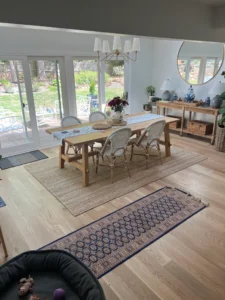
Unfinished hardwood floors require more delicate care because they don’t have a protective finish.
For unfinished hardwood floors, use a dust mop with a soft cloth pad to avoid scratching the wood. Avoid using water or harsh chemicals, as they can damage the wood.
In general, microfiber dust mops are the best choice for cleaning hardwood floors because they trap dust and debris without scratching the surface.
Features to Consider
When selecting a dust mop for hardwood floors, there are a few key features to consider.
Size is an important factor, as choosing the right size mop for the area being cleaned can make the task more efficient.
A mop that’s too large may be difficult to maneuver in tight spaces, while one that is too small may take longer to cover larger areas.
The material of the dust mop is also crucial, with microfiber being a popular choice for wood floors. Microfiber is highly effective at trapping dust and dirt particles and is gentle enough not to scratch or damage the floor’s surface.
Additionally, don’t forget about the handle of the dust mop! An adjustable handle can make cleaning more ergonomic, allowing you to adjust the length to suit your height and reach. This can help prevent strain and fatigue, especially during extended cleaning sessions.
Frequently Asked Questions
Can I use a vacuum instead of a dust mop on my hardwood floors?
Yes, you can use a vacuum on hardwood floors, but it’s important to use a vacuum with a hardwood floor setting or a brush attachment to avoid scratching the surface. Dust mops are generally more gentle and are specifically designed for hardwood floors.
How often should I use a dust mop on my hardwood floors?
How frequently you use your dust mop depends on the amount of foot traffic in your home. As a general rule, dust mop high-traffic areas once a day and less frequently in low-traffic areas.
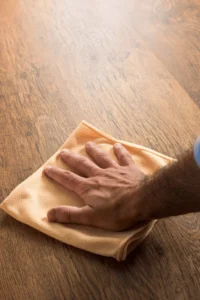
Can I use a wet dust mop for wood floors?
We don’t recommend using a wet dust mop on hardwood floors, as excess moisture can damage the wood. Instead, use a dry or damp dust mop.
How do I clean a microfiber dust mop head?
Most microfiber dust mop heads are machine washable. Remove the mop head from the frame and wash it in warm water with a mild detergent. Avoid using fabric softener, as it can reduce the effectiveness of the microfiber.
What should I do if my dust mop leaves streaks?
If your dust mop leaves streaks, check with your floor manufacturer that you’re using an approved cleaner (and for other cleaning tips for your particular floors).
Can I use a dust mop on hardwood floors with a wax finish?
Yes, you can use a dust mop on hardwood floors with a wax finish. However, be cautious not to use any cleaning solutions that may strip the wax finish. Dry or damp dust mopping is usually sufficient for maintaining waxed hardwood floors.
How do I prevent my dust mop from scratching my hardwood floors?
To prevent scratching, make sure your dust mop is clean and free of any debris that could scratch the floor. Avoid using dust mops with abrasive materials, and be gentle when using the mop to avoid applying too much pressure.
Can I use a dust mop on a floor that has been recently refinished?
It’s best to wait until the hardwood floors have fully cured before using a dust mop on them, which typically takes around 30 days. Using a dust mop too soon after refinishing could disrupt the curing process and potentially damage the finish. Always follow the recommendations provided by your flooring contractor for post-refinishing care.

